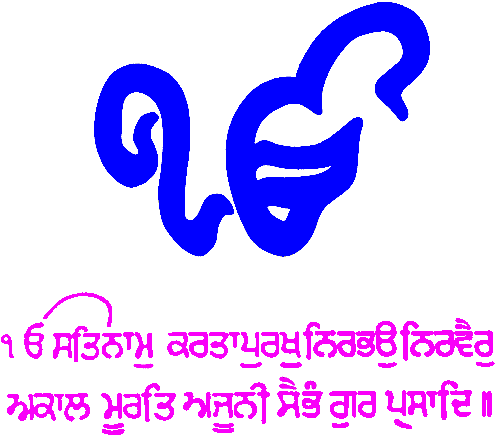
Gu means darkness or ignorance, and ru means light or knowledge. There were ten human Gurus until the last one granted Spiritual Guru status to the Adi Granth, known afterwards as the Guru Granth Sahib. The temporal Guru became the Khalsa, or Sikh community.
| 1. | Guru Nanak | (1469-1539) |
| He had a mixture of Hindu and Islamic influences. He refused the Hindu sacred thread ceremony at ten. His father in the commercial caste worked for a Muslim landlord in Talwandi. When thirty he vanished for three days, returned and announced his mission with the Mool Mantra (which was later placed into Sikh scriptures). In the context of strife, Guru Nanak stated Ek Ong Kar: we are all one, created by the One Creator of all Creation, and the Name of God is Truth, Sat Nam. | ||
Guru Nanak taught a spiritual way of life:
|
||
| 2. | Guru Angad | (1504-1552) |
| Improved and perfected Mahajni script for writing Punjabi (hymns of Guru Nanak) | ||
| 3. | Guru Amar Das | (1479-1574) |
| Missionaries and all eat together in a common kitchen | ||
| 4. | Guru Ram Das | (1534-1581) |
| Founded Amritsar | ||
| 5. | Guru Arjan | (1581-1606) |
| Built Harimandir (House of God), compiled the scripture (to become the Guru Granth Sahib) and was the first martyr as he was killed on the order of Mughul Jehangir in 1606 | ||
| 6. | Guru Hargobind | (1606-1644) |
| Patched up relations with the authorities and some battles | ||
| 7. | Guru Har Rai | (1630-1661) |
| Spiritual focus | ||
| 8. | Guru Har Krishen | (1656-1664) |
| Spiritual focus | ||
| 9. | Guru Tegh Bahadur | (1621-1675) |
| His hymns went into Adi Granth (making a second version), which became fully the Guru Granth Sahib but he was beheaded on the order of the Emperor of India in 1675 | ||
| 10. | Guru Gobind Singh | (1666-1708). |
| He is almost as important as Guru Nanak, one reason being ending the line of human Gurus. The temporal Guru became the Khalsa, into which he absorbed himself after its formation. He formed it by first asking for a volunteer and they went away. The first one seemed killed when the Guru returned with a blooded double edged sword - but more Sikhs then volunteered until five had gone altogether. All of them then returned alive, and were initiated into the Khalsa, the spiritual brotherhood and sisterhood devoted to purity of thought and action, giving them amrit (sugared water stirred with a two-edged sword). Being in the Khalsa means no sexual relationships outside marriage, no meat, tobacco, alcohol, and other intoxicants. All Sikhs since, who are baptised into the Khalsa, are identifiable by wearing the five Ks: | ||
|
||
| This soldier-saint said, When all other means have failed, only then is it righteous to take up the sword. He defended the poor, meek, and oppressed in India. | ||
|
|
|
|
|
|
|

The Mool Mantra (of which there are several translations, and the Gurmurkhi version is displayed above) stays that:
| Once at the website click for the daily Hukamnama from Amritsar. Scroll down to see the English if the Internet browser Gurmukhi font is not installed. The Guru Granth Sahib is opened randomly to any page and the shabad there becomes the day's Hukam (meaning command). This random method has existed since the Golden Temple was established with the Guru Granth Sahib in 1604. |
The Commandments of the ten Gurus:
Believe that:
Do not:
A baptised Sikh must wear the 5 Ks:
There is a prayer for the home installation of the Guru Granth Sahib:
|
Blessed is the hour when I see you I am glad to be in your presence You are the giver of my life, my beloved God; I maintain my whole being by keeping you in mind. Your teaching is true, your word is sweet, Your eyes see everything, you are calmness itself. Your patience is the source of my peace, Your Law is unchanging, my Sovereign. My God is beyond birth and death. |
Guru Arjan (trans. Piara Singh Sambhi), Adi Granth, 562
.
Adrian Worsfold